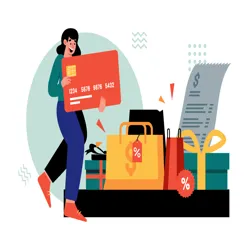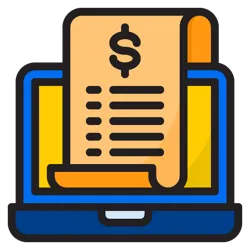TABLE OF CONTENTS
- What is Invoice Discounting?
- How Does Invoice Discounting Work?
- What are the Advantages?
- What Is Confidential Invoice Discounting?
- What Is Reverse Discount Factoring?
- Invoice Discounting vs Factoring
- Invoice Discounting vs Bill Discounting
- Final Thoughts: Does your business need invoice discounting?
Does your business need a more predictable flow of cash? If so, the way to increase the stream is to consider an invoice finance solution. Popular forms of invoice finance include invoice factoring and invoice discounting.
Invoice financing allows you to monetize your company’s outstanding invoices by receiving a percentage of the invoices’ value and paying a fee. Therefore, companies that need a temporary injection of short-term capital receive funds right away as opposed to waiting on customer payments. Read on to explore invoice discounting and how it differs from invoice factoring.
What is Invoice Discounting?
Invoice discounting allows a business to obtain quick cash through a special lender like a discounting company. The company lends the business a percentage of money listed in a company’s account’s receivable ledger. You can compare it to having overdraft protection secured against accounts receivable.
Therefore, invoice discounting allows a business to get instant cash that is otherwise tied up in unpaid invoices. When you invoice a customer, whether via mail or email, you receive a percentage of the total, automatically giving your business’s cash flow a needed boost.
When you receive payments from customers, you repay the loan, including an agreed fee covering the cost, interest, and risk. This type of program works out great for businesses that experience a slow cash flow from time to time.
How Does Invoice Discounting Work?
An invoicing discount program features 5 basic steps:

- The company makes an invoice for each customer with their information, date of the invoice, amount due, and buyer/seller information. If the customer does not pay, the company uses invoice discounting while trying to collect the debt.
- Unpaid invoices go to the lender or finance company for bill discounting. Details are provided in accounts receivable records. At this point, the bill discount lender reviews each invoice.
- After reviewing the unpaid invoices, the invoicing discount company gives the business a percentage of each invoice’s value. The rate and the length of time for receipt of the funds depend on the type of business, the amount of the invoice, and the bill discounting provider.
- In many cases, when using a bill discount service, a business carries out the collection process to collect the unpaid invoice debt. A lender may, in some instances, perform invoice collections on a company’s behalf. However, most businesses that use invoicing discount services take care of collections themselves.
- Once a customer pays the outstanding balance for an invoice, the discounting service pays the business the invoice balance, subtracting the interest and fee for the service.
How much does it cost?
Typically, the fee for bill discounting runs between 1% and 3% of each invoice total. These fees will depend on the lender you choose.
What are the Advantages?
The main advantages associated with invoice discounting finance include the following:
- Quick increase in cash flow
- Optimized working capital cycle
- Better control over accounts receivable
- Pay interest only on the borrowed amount
- Easier to pay suppliers
- Increased opportunities for business expansion and growth based on greater capital
What Is Confidential Invoice Discounting?
Confidential invoice discounting involves the same process as regular invoice discounting. However, the process is private. This means customers with unpaid invoices do not know about the arrangement. Companies may choose to keep their invoicing discount private for a number of reasons. Instead of the discounting company reaching out to the customers, it appears that all communication is coming from the original company.
What Is Reverse Discount Factoring?

Reverse discount factoring has its roots in the car industry, where large car manufacturers used the process to improve their cash flow with suppliers. [1]Oracle/NetSuite. “What Is Reverse Factoring?” Accessed October 25, 2021. Therefore, reverse factoring enables a larger company to pay a funder the full value of outstanding supplier invoices. In turn, the funder immediately remits payment to the supplier of what is owed. As a result, regular payment terms, such as 30 to 90 days, can be waived for a swifter cash flow.
Reverse discount factoring is usually helpful to suppliers that have had a long trading relationship with a large company, such as a retailer, or car manufacturer. This form of receipt processing allows a supplier to receive payments on time, which stabilizes the supply chain.
The service is provided for a fee and a low-interest charge. Funders only employ this finance arrangement if a large amount of factoring is involved.
Invoice Discounting vs Factoring
It’s important to know the differences between invoice discounting vs invoice factoring. Each invoice financing solution uses different methods for increasing cash flow. Invoicing discounting is a loan secured against outstanding invoices. Invoice factoring, on the other hand, serves as an alternative approach that involves selling the invoices to a factoring company.
The factoring company deals with the customers directly, which keeps a business from hunting down late payers. However, this method can prove problematic, especially if the factoring company takes severe measures to secure a late payment.
Invoice discounting involves taking out a loan on the invoices as opposed to selling the bills. A factoring company runs credit checks on customers before it agrees to buy company invoices. However, a discounting company does not have to be as thorough since they are not buying the entire cash flow; they are simply taking out a loan against it.
Invoice Discounting vs Bill Discounting
While invoice discounting may sound the same as bill discounting, they are different. The main variance covers the billing terms. While invoice discounting is set up to use a loan to cover unpaid invoices for up to 90 days (30, 60, and 90 net payment terms), bill discounting is designed to cover a period from 30 to 120 days.
Final Thoughts: Does your business need invoice discounting?
A large number of businesses can benefit from invoice discounting. By using invoicing discount services, a company can receive an advance on approved invoices. The business, in turn, retains control over its sales ledger and collections.
Examples of businesses that use invoice discounting include companies that sell electronics or electrical products, recruiting firms, plastics companies, logistics firms, storage businesses, clothing companies, wholesale distributors, and warehousing businesses.
To enjoy these benefits, review your cash flow and see where you can use the practice to increase revenue, pay suppliers, or improve customer relationships.






